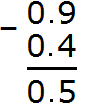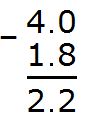When subtracting decimals, you must follow the same rules as for addition: "point under the point" and "equal number of digits after the point".
Example 1. Find the value of the expression 2.5 - 2.2
Write the expression in columns, following the rule "point under the point":

Calculate the fractional part 5-2=3. Write the number 3 in the tenth part of our answer:

Calculate the whole part 2-2=0. Write zero in the whole part of our answer:

Separate the whole part from the fractional part with a dot:

The answer is 0.3. So the value of the expression 2.5 - 2.2 is 0.3
2.5 − 2.2 = 0.3
Example 2. Find the value of the expression 7.353 - 3.1
The number of digits after the decimal point is different in the expression. There are three digits after the dot in fraction 7.353, and only one digit in fraction 3,1. So in the fraction 3.1, two zeros must be added at the end to make the number of digits in both fractions the same. Then we get 3.100.
Now we can write the expression in the column and calculate it:

The answer is 4.253. So the value of the expression 7.353 - 3.1 is 4.253
7.353 — 3.1 = 4.253
As with regular numbers, sometimes you will have to borrow a unit from a neighboring digit if subtraction becomes impossible.
Example 3. Find the value of the expression 3.46 - 2.39

Subtract the hundredths of 6-9. You cannot subtract 9 from the number 6. So you need to take one from the next digit. By taking one from the next digit, number 6 turns into number 16. Now you can calculate the hundredths of 16-9=7. Write the seven in the hundredth part of our answer:

Now subtract the tenths. Since we took one unit in the tenths digit, the digit that was located there has decreased by one unit. In other words, the digit in the place of tenths is no longer 4, but 3. Let's calculate tenths 3-3=0. Write zero in the tenth part of our answer:

Now subtract the whole parts 3-2=1. Write one in the whole part of our answer:

Separate the whole part from the fractional part with a dot:

The answer is 1.07. So the value of the expression 3.46-2.39 is 1.07
3.46−2.39=1.07
Example 4. Find the value of the expression 3-1.2
In this example, a decimal is subtracted from a whole number. Write this expression in the column so that the whole part of the decimal 1.23 is under the number 3

Now make the number of digits after the dot the same. To do this, put a dot after the number 3 and add a zero:

Now subtract the tenths: 0-2. The number 2 cannot be subtracted from zero. That is why we need to take one from the next digit. By taking one from the neighboring digit, 0 turns into 10. Now we can calculate the tenths of 10-2=8. Write the eight in the tenth part of our answer:

Now we subtract the integers. The whole used to be number 3, but we took one unit away from it. As a result, it turned into number 2. So we subtract 1 from 2. 2−1=1. Write one in the whole part of our answer:

Separate the whole part from the fractional part with a dot:

The answer is 1.8. So the value of the expression 3-1.2 is 1.8.
3 − 1.2 = 1.8




2. If you find an error or inaccuracy, please describe it.
3. Positive feedback is welcome.